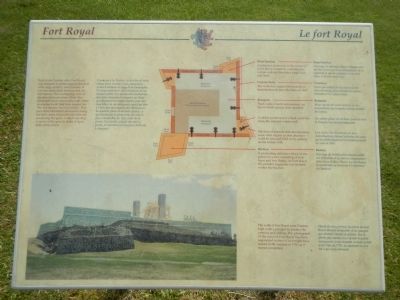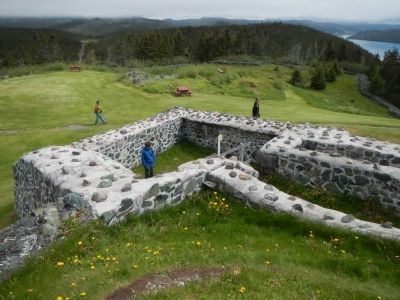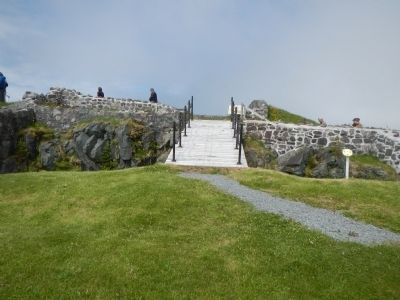Near Placentia in Avalon Peninsula, Newfoundland, Newfoundland and Labrador — The Atlantic Provinces (North America)
Fort Royal (Plaisance)
le fort Royal
Built in the Vauban style, Fort Royal was designed to protect against attackers with siege artillery and muskets. It contains three demi-bastions and one full bastion. The overlapping faces of the demi-bastions form a flank that eliminated places close to the walls where an attacker could hide from musket fire. The full bastion has two flanks. This provided additional protection along the fort’s most vulnerable face (the one containing the gate). A ditch was dug in front of the gate to make it more difficult to attack.
The walls of Fort Royal were 5 metres high with a parapet to protect the cannons and soldiers. This photograph of the ruins of Fort Royal has been augmented to show it as it might have looked in the summer of 1702, as it neared completion.
French
Construit a la Vauban, le fort Royal était conçu pour résister à des attaquants armés d’artillerie de siège et de mousquets. Il comprenait trois demi-bastions et un bastion plein. Les parois chevauchantes des demi-bastions formaient un flanc qui éliminait les angles morts près de murailles où en attaquant aurait pu être à l’abri de mousquets des défenseurs. Le bastion plein avait deux flancs, ce qui renforçait la protection du côté le plus vulnérable du fort, celui de la porte. Un fossé, creusé devant la porte, la rendait encoure plus difficile à attaquer.
Hauts de cinq mètres, les murs de fort Royal étaient surmontés d’un parapet qui abritait canons et soldats, Sur la photo des ruines, on a ajouté la partie manquante pour montrer ce dont le fort avait l’air en 1702, au moment où il a été à peu près terminé.
Click on the image of the marker to enlarge it and identify these points of interest.
Captions (English / French): Demi-Bastion A defensive protrusion at the corner of a fort that is created by extending the curtain wall and forming a single face and flank. / Demi-bastion Ouvrage de defense situé à chaque coin du fort formé par le prolongement de la courtine et qui se compose d’un seul flanc et d’une seule face.; Curtain Walls The walls that connect the bastions or demi-bastions to form the sides of a fort. / Courtines Murs que relient les bastions ou les demi-bastions pour former les parsis latérales d’une place forte.; Ramparts Thick walls of earth and masonry on top of which cannon are mounted. / Remparts Murs épals de terre et de maçonnerie sur lesquels étaient montés les canon.; A soldier positioned at a flank could fire along the adjacent curtain wall. / Un soldat placé sur le flanc pouvait tiret le long de la courtine adjacente.; The faces of bastions and demi-bastions were often angled so that attackers could be seen and fired on by soldiers on the curtain wall. / Les faces des bastions et des demi-bastions étaient inclinées de sorte qu’un soldat placé sur la courtine pouvait les voir et tirer.; Bastion A protruding defensive block at the corner of a fort consisting of two faces and two flanks. At Fort Royal the powder magazine was housed within the bastion. / Bastion Ouvrage de fortification faisant saillie sur l’enceinte d’un fort et comprenant deux faces et deux flancs. Au fort Royal, la poudrière se trouvait à l’intérieur du bastion.
Erected by Parks Canada.
Topics. This historical marker is listed in this topic list: Forts and Castles. A significant historical year for this entry is 1702.
Location. 47° 15.072′ N, 53° 58.291′ W. Marker is near Placentia, Newfoundland and Labrador, in Avalon Peninsula, Newfoundland. Marker can be reached from Castle Hill Road. Touch for map. Marker is in this post office area: Placentia NL A0B, Canada. Touch for directions.
Other nearby markers. At least 5 other markers are within walking distance of this marker. Port Royal and Castle Graves (a few steps from this marker); (Fort Royal) (a few steps from this marker); Castle Hill (within shouting distance of this marker); a different marker also named Castle Hill (within shouting distance of this marker); Fort Frederick (approx. 0.8 kilometers away).


